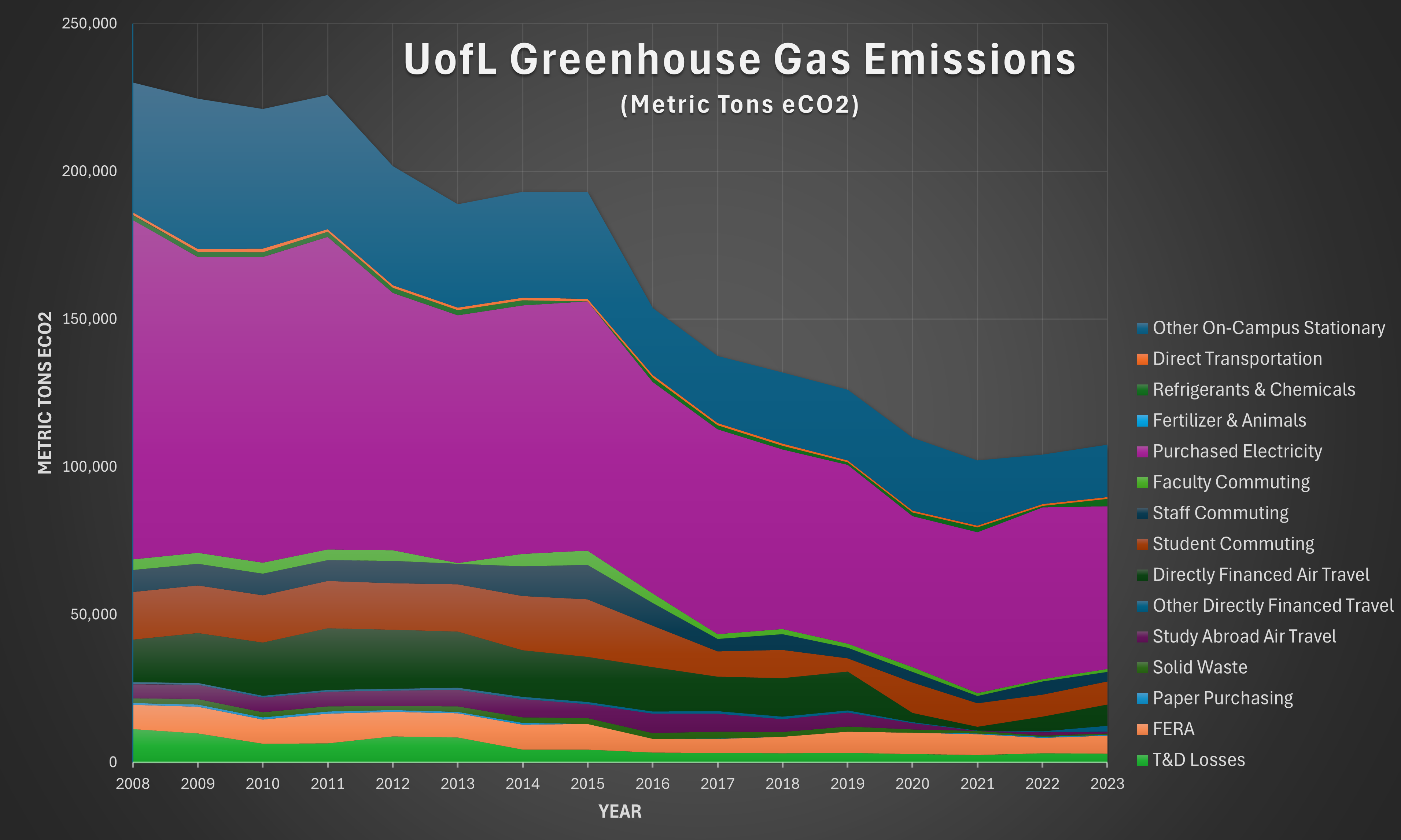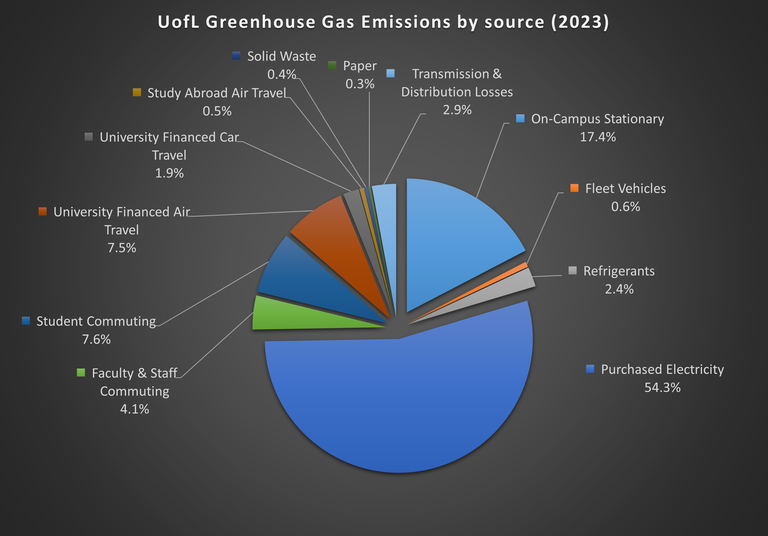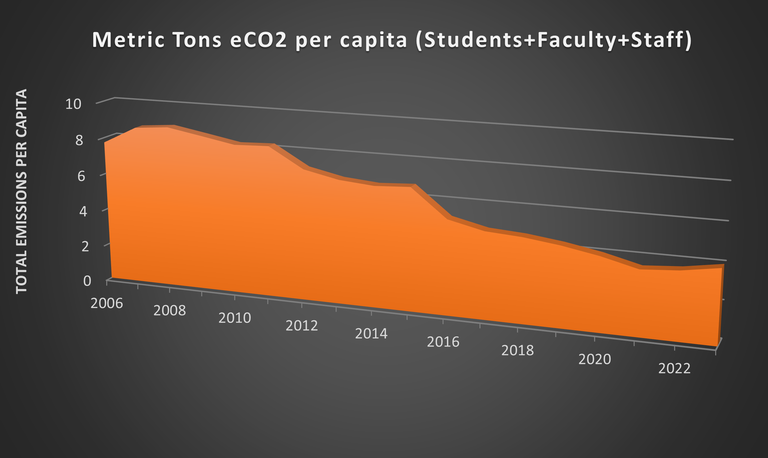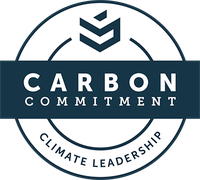Climate Action Plan
 This work supports our CARDINAL principles: Community of Care, Accountability, Integrity & Transparency, Noble Purpose, Agility, and Leadership.
This work supports our CARDINAL principles: Community of Care, Accountability, Integrity & Transparency, Noble Purpose, Agility, and Leadership.
In 2008, UofL became a signatory to the American College & University Presidents’ Climate Commitment, which is now known simply as the Carbon Commitment. As a member of the Climate Leadership Network, the University of Louisville is committed to reducing greenhouse gas (GHG) emissions with the ultimate goal of achieving carbon neutrality by 2050 at the latest.
On June 16, 2025, President Gerry Bradley re-signed UofL to the Carbon Commitment, reaffirming the university’s commitment to tackling the greatest crisis facing humanity (just as his predecessors, Kim Schatzel did on February 1, 2024, Neeli Bendapudi did on August 4th, 2021, and James Ramsey did in 2008). Read President Bradley's carbon commitment here.
During our first decade of Climate Action, UofL was able to vastly exceed our goals laid out in the university's first Climate Action Plan, which was adopted on September 15, 2010, after benchmarking our carbon footprint with our 2008 Greenhouse Gas Emissions Baseline Inventory. That Plan set a goal of reducing net carbon emissions by 20% by 2020. In fact, the university was able to achieve an over 48% reduction by that year and our latest Greenhouse Gas Emissions report indicates that we had achieved a stunning 51% reduction in carbon emissions from our 2008 baseline by the end of 2023.
You can find all the details about UofL's greenhouse gas emissions reporting publicly available on the new Sustainability Indicator Management & Analysis Platform (SIMAP), or explore our full 2023 Greenhouse Gas Emissions Report.
To reflect the past decade of experience and set new goals, during 2021-22, UofL's Sustainability Council worked to produce a revised Climate Action Plan as a component of our new UofL Sustainability Plan: Pathway to Platinum. It is a comprehensive roadmap for reducing our emissions down to net zero. It was shared with the campus population for comment in January 2022 and a final draft was submitted to the administration on May 27, 2022. From July 2022 - July 2023, this revised Climate Action Plan was integrated into the first comprehensive Campus Master Planning effort the university has conducted in 15 years. The Sustainability Council coordinates UofL's Climate Action Planning as well as the reporting of our greenhouse gas emissions.

Our efforts to implement our Climate Action Plan (CAP) continue to pay off. We have made great strides in the last decade, and have demonstrated our ability to exceed our goals. Yet our work is not done. Achieving climate neutrality for a large institution like ours is a marathon not a sprint. Further and even more significant investments will be needed to achieve our ultimate goal of carbon neutrality, as well as some of the initial goals we have yet to achieve, such as sourcing 20% of our energy from renewable sources.
Like many institutions, UofL also faces the challenge of "building back better" after the COVID-19 pandemic. As commuting, air travel, and many energy-consuming campus activities cratered during the pandemic, so did our carbon emissions. While some of these habits have stuck with us, such as the widespread use of remote learning and work, other behaviors are returning to pre-pandemic patterns and we've seen a resulting rise in UofL's net carbon emissions by 4% from 2021 to 2022. For the sake of humanity, we cannot allow this upward trajectory to continue. While our overall progress should be celebrated, the latest science on the global climate crisis suggests that we must take even more aggressive action to cut emissions if we are to avoid the worst effects of runaway climate change.
Though we have made great progress, more funding is needed to address the remaining challenges outlined in the UofL Sustainability Plan: Pathway to Platinum. The UofL Sustainability Council has not received additional resources to tackle these challenges since 2017, when the Climate Action Plan implementation budget was slashed to a minimal operating level of $45,000/year (25% of historical funding levels). Increased investment in climate action will not only reduce our greenhouse gas emissions, but can help reduce the university's costs while increasing our profile, providing new educational and research opportunities, and improving the health and wellness of our students, faculty, and staff. These are vital investments for the sake of our students’ futures, and, indeed, for our common future.
When we look over the long-term, UofL can be particularly proud of the fact that we have reduced our carbon emissions, even as we continue to grow in terms of physical size, campus population, and budgetary expenditures. In fact, UofL has achieved the following relative reductions in emissions over time:
| Per sq. ft. of building space |
Per Capita (Students+Employees) |
Per Operating Budget Dollar |
|
|---|---|---|---|
| Emissions Reduction 2008-2023 | 67% | 55% | 74% |
From 2008 to 2023, we estimate that UofL’s net carbon emissions have declined by 51% from 221,603 to 108,019 metric tons of carbon dioxide equivalent per year.
 Given that the social cost of carbon is now estimated to be $185/ton of carbon emissions (according to more recent studies in 2023; or $51/ton as estimated by the Biden Administration), UofL's emissions in 2022-2023 were responsible for something on the order of $5-18 million/year in damage to our planet and its people. It is not acceptable or in line with our CARDINAL principles to continue externalizing these costs and imposing such a debt on the future generations for whom UofL ought to be a source of hope and flourishing.
Given that the social cost of carbon is now estimated to be $185/ton of carbon emissions (according to more recent studies in 2023; or $51/ton as estimated by the Biden Administration), UofL's emissions in 2022-2023 were responsible for something on the order of $5-18 million/year in damage to our planet and its people. It is not acceptable or in line with our CARDINAL principles to continue externalizing these costs and imposing such a debt on the future generations for whom UofL ought to be a source of hope and flourishing.
In 2023, we stood at a 51% reduction from the 2008 baseline. UofL decreased emissions by 113,584 metric tons of CO2 equivalent per year since 2008. According to the EPA's greenhouse gas equivalencies calculator, this translates to:
- Taking 25,196 cars off the road, or over 275M miles of driving, or 12.1M gallons of gas burned;
- 38,169 tons or 5,453 garbage trucks) of waste recycled instead of landfilled;
- Emissions from 14,507 average U.S. homes’ annual energy use;
- 599 rail cars worth of coal burned;
- Over 8 billion smartphones charged;
- Carbon sequestered by 108,349 acres of U.S. forests in one year; or over 1 million tree seedlings grown for 10 years; or 645 acres of U.S forests preserved from conversion to cropland in a year.

While this reduction is important and laudable, this is no time for complacency. Our net emissions rose 2% from 2021-22 and the overall trends do not represent a steep enough decline to achieve our goal of climate neutrality by 2050. We must remain vigilant, committed, and willing to invest new resources in order maintain our progress and to ensure a sustained effort toward our ultimate goal of climate neutrality by 2050. We must continue to invest in emissions reduction, to innovate solutions that work in our unique urban setting, and to prioritize efficiency, behavior change, transportation alternatives and renewable energy.
The most important steps that UofL needs to take in the near-term are:
- Invest in large-scale renewable energy, both on-campus (as in an anaerobic biodigestor) and off-campus (as through a virtual power purchase agreement).
- Develop a Transportation Demand Management Plan that caps parking, incentivizes alternatives (including remote work/learning), and transitions UofL from subsidizing annual parking permits to market-rate, pay-per-use parking that subsidizes alternatives.
-
Develop a Sustainable Travel Policy and promote alternative options to air travel, by implementing strategies like providing incentives for eco-friendly ground transportation. This could diminish travel necessity and ensure minimal emissions when it is necessary. UofL ought to consider the development of a sustainable travel portal to facilitate low-carbon travel planning, and offer a convenient, reliable way for travelers to offset their emissions at the time of purchase.

President Schatzel signs Climate Leadership Commitment as UofL reduces carbon emissions by 53% (UofL Sustainability News, Feb. 2, 2024)
Kentucky colleges have lofty climate goals but struggle to cut greenhouse emissions (Courier-Journal, July 8, 2019)
University of Louisville Falls Behind on Climate Change Goals (WFPL, July 2, 2019) Carbon Neutral (Sustain: A Journal of Environmental and Sustainability Issues, Issue 38, Spring/Summer 2018)
Carbon Neutral (Sustain: A Journal of Environmental and Sustainability Issues, Issue 38, Spring/Summer 2018)
- Shrinking Emissions & Expanding Minds at the University of Louisville, p. 16-25.
UofL study: Heat, health risks worsen by 2050 (Courier-Journal, Nov. 14, 2016)
Perspectives on Climate Change (UofL Arts & Sciences, Oct. 2015)
UofL’s emissions down (UofL Today, Jan. 27, 2014)
UofL Reports Reduction in Carbon Dioxide Emissions (WFPL, Jan. 24, 2014)
University of Louisville is on its way to carbon neutrality (Louisville Alternative Energy Examiner, January 31, 2012)
For historical perspective, see our:
- 2022 Greenhouse Gas Emissions Report (released March 2024)
- 2020 Greenhouse Gas Emissions Report (released May 2021)
- 2019 Greenhouse Gas Emissions Report (released May 2020)
- 2018 Greenhouse Gas Emissions Report (released June 2019)
- 2017 Greenhouse Gas Emissions Report (released May 2018)
- 2016 Greenhouse Gas Emissions Report (released May 2017)
- 2015 Greenhouse Gas Emissions Inventory (released January 2016)
- 2013 Greenhouse Gas Emissions Inventory (released January 2014)
- 2010 Greenhouse Gas Emissions Inventory (released September 2011)
- 2008 Greenhouse Gas Emissions Baseline Inventory (released September 2009)
Climate Action Plan
UofL adopted our first Climate Action Plan in 2010, which contained roughly 175 different recommendations designed to raise awareness, educate, research, and invest in addressing the climate crisis. The 2010 Plan set goals for the university which seemed at the time, given our limited experience and knowledge, to be a reasoned balance between achievable and aspirational: a reduction in net greenhouse gas (GHG) emissions from our 2008 benchmark of 20% by 2020, 40% by 2030, and 100% by 2050. In our first decade of implementing the Plan, we learned a lot more about what we are capable of and that our initial goals were too modest. By 2020, we had already achieved a 35% reduction in our net carbon emissions!
To reflect our first decade of experience and set new goals, during 2021-22, UofL's Sustainability Council worked to produce a revised Climate Action Plan as a component of our new UofL Sustainability Plan: Pathway to Platinum. It was shared with the campus population for comment in January 2022 and a final draft was submitted to the administration for consideration on May 27, 2022. The revised Plan better reflects the urgency of the climate crisis and sets new target goals for university-wide reductions in carbon emissions from our 2008 benchmark estimate of 212,487 metric tons of carbon dioxide equivalent (MT eCO2) as follows:
Goals |
Target Year |
Reduction in |
Target maximum |
Short Term |
2030 |
60% |
88,642 |
Mid Term |
2040 |
80% |
44,321 |
Long Term |
2050 |
100% |
0 |
It also sets a more ambitious Renewable Energy Goal of 50% in 2030 and 100% in 2050.
Our plan for making progress toward climate neutrality is dynamic and multifaceted. We recognize that sustainability demands progress on multiple fronts and that lasting change cannot be achieved without coordinated efforts campus-wide. As such, we propose taking a variety of steps to lead UofL down a path toward climate neutrality with a focus on the following initiatives: ethical purchasing; energy conservation and efficiency; renewable energy; carbon sequestration; master planning; green building design; composting and horticultural practices; behavior change; recycling; transportation; food; and carbon offsets.
UofL's Climate Action Plan is designed to be a living document that we will continue to revisit and refine as we go through a four decade process of adaptive management on the road to climate neutrality. Engaging students, faculty, researchers, staff and the broader community in this process will be vital to its success and to our broader educational and research mission. This plan is a key element in our sustainability initiatives, and it involves many steps that will help us achieve our strategic goals as well as our climate commitment. It is also the right thing to do in a world of dwindling fossil fuel resources and worsening climate crisis.
UofL departments, employees & students are encouraged to offset carbon emissions through a service such as Climate Vault, which uses your donation to buy carbon pollution permits on government regulated cap & trade markets and then use them to fund highly vetted, government regulated projects that remove carbon from the atmosphere. Other options include Patch (official partner of the Carbon Commitment/Second Nature), Carbon Footprint Ltd, Native Energy, CarbonFund, TerraPass, or for free (through commissions) with UCapture.



